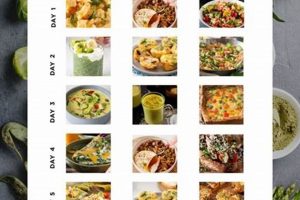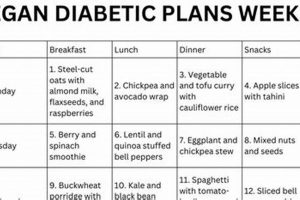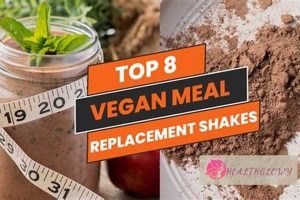Preparation of plant-based meals, specifically designed to facilitate a reduction in body mass, involves careful planning and execution. This approach utilizes exclusively plant-derived ingredients to create balanced, portion-controlled meals intended for consumption over multiple days. An example includes preparing several containers with quinoa, roasted vegetables, and lentils on a Sunday for lunches throughout the work week.
Adopting this method offers several advantages. It promotes adherence to a defined dietary strategy, mitigates the potential for impulsive, less healthful food choices, and optimizes time management. Historically, the concept of preparing meals in advance has been a cornerstone of efficient food management; its integration with plant-based eating aligns with contemporary health and ethical considerations.
The subsequent discussion will delve into crucial aspects such as selecting appropriate recipes, understanding macronutrient ratios, addressing potential nutritional deficiencies, and implementing practical storage and reheating techniques for successfully executing a strategy focused on plant-based dietary management and achieving desired body composition goals.
Practical Guidance for Plant-Based Calorie Control
The following recommendations provide a framework for effective plant-based meal preparation intended to support weight reduction. These guidelines emphasize nutrient density, portion control, and efficient planning.
Tip 1: Prioritize Whole, Unprocessed Foods: Base meals around vegetables, fruits, legumes, and whole grains. These foods are generally lower in calorie density and higher in fiber, promoting satiety.
Tip 2: Calculate Macronutrient Ratios: Establish appropriate protein, carbohydrate, and fat targets. A common starting point is a 30/40/30 split, but individual needs may vary based on activity level and metabolic factors.
Tip 3: Implement Portion Control: Utilize measuring cups and food scales to accurately portion servings. This helps prevent overconsumption, especially with calorie-dense foods like nuts and seeds.
Tip 4: Diversify Recipe Selection: Incorporate a variety of recipes to ensure a broad spectrum of nutrients and prevent dietary monotony, which can lead to non-adherence.
Tip 5: Schedule Dedicated Preparation Time: Allocate a specific block of time each week for meal preparation. Sunday is often a convenient day, but the optimal time depends on individual schedules.
Tip 6: Employ Proper Storage Techniques: Utilize airtight containers and refrigerate meals promptly after preparation. This extends shelf life and minimizes the risk of bacterial contamination. Most prepared meals are safe for consumption within three to four days.
Tip 7: Plan for Variety and Flavor: Incorporate herbs, spices, and low-calorie sauces to enhance palatability without adding significant calories. Experimentation with different flavor profiles is crucial for long-term adherence.
Achieving successful outcomes requires consistent effort and attention to detail. These guidelines should serve as a foundation for establishing sustainable, healthy eating habits.
The subsequent section will address common challenges and provide strategies for overcoming obstacles that may arise during the execution of a structured plant-based weight management program.
1. Calorie Density Awareness
Calorie density awareness constitutes a critical element within the framework of plant-based meal preparation for weight reduction. It addresses the fundamental principle that foods with lower calorie density provide greater satiety per calorie consumed, a factor directly impacting the success of a weight loss strategy. The inverse relationship between volume and caloric content becomes particularly significant when adhering to a plant-based diet, given the inherent abundance of high-volume, low-calorie options such as vegetables and fruits. For example, a 200-calorie serving of broccoli provides significantly more volume and fiber, leading to greater feelings of fullness, compared to a 200-calorie serving of processed vegan snacks, thereby influencing subsequent food intake. An understanding of this principle allows for strategic meal construction that prioritizes voluminous, low-calorie foods to promote satiety and facilitate adherence to a reduced-calorie intake.
Effective application of calorie density awareness involves careful selection of ingredients and recipe modification. For instance, substituting refined grains with whole grains and increasing the vegetable-to-grain ratio in dishes can markedly reduce the overall calorie density. Similarly, incorporating large quantities of non-starchy vegetables, like spinach or zucchini, into soups and stews adds volume without substantially increasing calorie content. Analyzing and adapting existing recipes to minimize added fats and sugars, common in some prepared vegan foods, also contributes to reduced calorie density. The practical implementation of this knowledge empowers individuals to make informed food choices that support their weight management objectives within the constraints of a plant-based diet.
In summary, calorie density awareness serves as a cornerstone for effective plant-based meal preparation targeted toward weight loss. By prioritizing low-calorie-density foods and strategically modifying recipes, individuals can create meals that promote satiety while remaining within a defined caloric range. The challenge lies in consistent application and education regarding the relative calorie densities of various plant-based foods, enabling sustained adherence and long-term weight management success. This understanding is essential for navigating the complexities of a plant-based diet while simultaneously pursuing a weight reduction goal.
2. Macronutrient Optimization
Macronutrient optimization represents a fundamental aspect of effective plant-based meal preparation when pursuing weight reduction. Precise control over protein, carbohydrate, and fat intake is crucial for achieving a caloric deficit while preserving lean body mass and ensuring adequate energy levels. This requires a strategic approach to recipe selection and portioning to align with individual metabolic requirements and weight loss goals.
- Protein Sourcing and Distribution
Plant-based protein sources, such as legumes, tofu, tempeh, and seitan, must be strategically incorporated into meals to meet daily protein targets. Distributing protein intake evenly throughout the day, rather than consuming a large portion in one meal, optimizes muscle protein synthesis and promotes satiety. A typical example includes incorporating lentils into a lunch salad and tofu into a dinner stir-fry. Insufficient protein intake can lead to muscle loss during weight reduction, negatively impacting metabolic rate.
- Carbohydrate Selection and Timing
The focus should be on complex carbohydrates from whole grains, vegetables, and fruits, as these provide sustained energy and fiber. Limiting refined carbohydrates and added sugars is essential for minimizing blood sugar spikes and promoting fat loss. Timing carbohydrate intake strategically, such as consuming a portion pre- or post-exercise, can enhance performance and recovery. An example would be consuming a serving of quinoa before a workout.
- Fat Intake and Source Quality
While often minimized during weight loss, adequate healthy fat intake is vital for hormone production, nutrient absorption, and satiety. Sources such as avocados, nuts, seeds, and olive oil should be included in moderate amounts. Prioritizing unsaturated fats over saturated and trans fats is crucial for cardiovascular health. For instance, adding a tablespoon of flaxseeds to breakfast provides essential omega-3 fatty acids.
- Balancing Macronutrient Ratios
Achieving an optimal macronutrient ratio, which may vary based on individual factors like activity level and metabolic rate, is essential for sustained weight loss. A common starting point is a 30/40/30 split of protein, carbohydrates, and fats, respectively. However, adjustments may be necessary based on individual responses and goals. Regular monitoring and adjustments to macronutrient ratios, guided by progress and individual needs, are critical for long-term success.
The interplay between these facets underscores the importance of a holistic approach to macronutrient optimization within the context of plant-based weight loss preparation. By carefully selecting ingredients, controlling portion sizes, and strategically timing macronutrient intake, individuals can effectively manage their weight while adhering to a vegan dietary pattern. Continuous monitoring and adjustments are essential for achieving and maintaining long-term success.
3. Portion Size Control
Portion size control is an indispensable element of effective plant-based meal preparation for weight reduction. When adhering to a vegan dietary pattern, even healthful foods, if consumed in excessive quantities, can impede progress toward weight loss goals. The energy density of certain plant-based items, such as nuts, seeds, and oils, necessitates careful regulation of serving sizes. For example, while almonds are a nutritious snack, a single serving (approximately 23 almonds) contains a significant number of calories. Without conscious portion management, frequent consumption of seemingly healthy, calorie-dense foods can easily lead to caloric surplus, thereby negating the benefits of plant-based eating for weight management.
The practical application of portion control within plant-based meal preparation involves several strategies. Pre-portioning meals into individual containers before the week begins eliminates the need for on-the-spot estimations, reducing the likelihood of overeating. Utilizing smaller plates and bowls can create a visual illusion of larger portions, potentially increasing satiety with smaller amounts of food. Accurately measuring ingredients during the cooking process and consulting nutrition labels to determine appropriate serving sizes are also essential components of successful portion management. An illustrative instance involves preparing a large batch of lentil soup, then dividing it into appropriately sized containers (e.g., 1.5 cups per serving) to ensure consistent caloric intake across multiple meals.
In summary, the conscious implementation of portion size control is paramount for maximizing the effectiveness of plant-based meal preparation for weight loss. Its absence can undermine the benefits of a vegan diet by leading to excessive caloric consumption, even from nutritious sources. Successful integration of portion control hinges on consistent pre-planning, accurate measurement, and a mindful approach to serving sizes. The combination of a well-structured plant-based meal plan and rigorous portion management is crucial for achieving sustainable and healthful weight reduction.
4. Nutrient Timing Strategy
Nutrient timing strategy, when integrated with planned vegan meals, assumes significance in optimizing metabolic processes and supporting weight reduction. The strategic allocation of macronutrients throughout the day, especially around periods of physical exertion, influences factors such as energy expenditure, muscle protein synthesis, and appetite regulation.
- Pre-Exercise Carbohydrate Provision
Consuming complex carbohydrates prior to physical activity provides a readily available energy source, sustaining performance and delaying fatigue. Example: A serving of overnight oats with berries consumed approximately 60-90 minutes before exercise. This approach spares muscle glycogen and can enhance fat oxidation during the workout. In the context of vegan meal prep, pre-portioned containers with suitable carbohydrate sources simplify adherence to this timing strategy.
- Post-Exercise Protein and Carbohydrate Intake
Following exercise, the consumption of protein and carbohydrates stimulates muscle protein synthesis and replenishes glycogen stores. Vegan-friendly options include a smoothie with plant-based protein powder, fruit, and plant-based milk or a serving of lentil soup with whole-grain bread. Prepared meals stored in advance facilitate immediate nutrient provision post-exercise, capitalizing on the body’s heightened sensitivity to nutrient uptake during this period.
- Optimizing Satiety Through Consistent Meal Spacing
Regular meal intervals, achieved through structured meal preparation, contribute to stable blood sugar levels and reduced cravings. A consistent schedule of breakfast, lunch, and dinner, with appropriately sized portions prepared in advance, mitigates the risk of impulsive food choices and promotes adherence to a caloric deficit. For example, planning and packing three complete meals and snacks each day ensures a steady supply of nutrients and minimizes hunger pangs.
- Evening Carbohydrate Modulation
Modulating carbohydrate intake in the evening may influence overnight fat oxidation. Reducing the proportion of carbohydrates in the evening meal and emphasizing protein and fiber can promote stable blood sugar levels during sleep. Examples include a tofu scramble with vegetables or a salad with chickpeas and avocado. Incorporating this strategy into a weekly preparation schedule involves selecting recipes with lower carbohydrate content for evening meals and ensuring their availability.
The implementation of nutrient timing strategies within the framework of planned vegan meals requires attention to both the composition and the scheduling of food intake. By aligning nutrient delivery with specific physiological needs throughout the day, individuals can potentially enhance the effectiveness of their weight reduction efforts while adhering to ethical and dietary preferences.
5. Recipe Diversity Implementation
The successful execution of “vegan weight loss meal prep” hinges significantly on effective recipe diversity implementation. Monotony in meal plans, characterized by repetitive consumption of the same few dishes, often leads to decreased adherence and a higher likelihood of dietary relapse. The absence of variety can result in nutrient deficiencies, as reliance on a limited selection of ingredients restricts the range of vitamins, minerals, and phytonutrients consumed. For example, a meal plan consisting primarily of rice and beans, while providing protein and carbohydrates, may lack essential fatty acids found in avocados or flaxseeds, or the diverse array of antioxidants present in colorful vegetables.
To counteract these challenges, a well-structured “vegan weight loss meal prep” program incorporates a wide range of recipes, utilizing a variety of plant-based ingredients. This approach necessitates planning meals that span different culinary styles and flavor profiles. An effective strategy includes scheduling distinct ethnic cuisines throughout the week, such as Indian lentil curries, Mediterranean quinoa salads, and East Asian tofu stir-fries. Rotation of ingredients, such as switching between different legumes (e.g., chickpeas, black beans, kidney beans) and grains (e.g., quinoa, brown rice, oats), ensures a broader spectrum of nutrients and prevents taste fatigue. Recipe diversity also facilitates creative utilization of seasonal produce, maximizing nutrient intake and reducing food costs.
In conclusion, “Recipe Diversity Implementation” is not merely a desirable addendum, but a crucial component of sustainable “vegan weight loss meal prep”. The strategic inclusion of varied and nutritionally complete recipes mitigates the risks of dietary boredom, nutrient deficiencies, and subsequent abandonment of the dietary program. A proactive approach to recipe planning, incorporating a diverse range of ingredients and culinary styles, enhances both the nutritional adequacy and palatability of plant-based meals, thereby increasing the likelihood of long-term success in weight management.
Frequently Asked Questions
The following questions and answers address common inquiries and concerns regarding the implementation of a vegan diet specifically designed for weight reduction, utilizing meal preparation strategies.
Question 1: Is a vegan diet inherently conducive to weight loss?
A vegan diet, by its exclusion of animal products, often leads to a lower intake of saturated fats and processed foods. However, weight loss is primarily determined by creating a caloric deficit. A poorly planned vegan diet, high in processed carbohydrates and unhealthy fats, can impede weight loss efforts. Calorie control remains paramount.
Question 2: What are the key nutrients to monitor when engaging in vegan weight loss meal prep?
Specific attention should be directed toward adequate intake of vitamin B12, vitamin D, iron, calcium, omega-3 fatty acids, and zinc. Plant-based sources for these nutrients require careful planning and may necessitate supplementation to prevent deficiencies. Consultation with a registered dietitian is advisable.
Question 3: How does one ensure adequate protein intake on a vegan weight loss meal prep plan?
Protein intake should be prioritized from sources such as legumes (lentils, beans, chickpeas), tofu, tempeh, seitan, and plant-based protein powders. Combining different protein sources can optimize amino acid profiles. Portion sizes must be appropriately adjusted to meet individual protein requirements.
Question 4: What is the optimal macronutrient ratio for vegan weight loss meal prep?
The ideal macronutrient ratio varies depending on individual factors such as activity level, metabolic rate, and body composition goals. A general guideline is a 30% protein, 30% fat, and 40% carbohydrate distribution. However, adjustments may be necessary based on individual response and progress.
Question 5: What are some common pitfalls to avoid when preparing vegan meals for weight loss?
Common pitfalls include over-reliance on processed vegan foods, excessive use of oils and added sugars, insufficient protein intake, and inadequate portion control. Diligent attention to ingredient selection, cooking methods, and serving sizes is essential.
Question 6: How can one maintain variety and prevent dietary boredom in vegan weight loss meal prep?
Implementing a diverse range of recipes, incorporating different culinary styles, utilizing seasonal produce, and experimenting with various spices and herbs are effective strategies. Rotating ingredients and exploring new plant-based protein sources also contribute to dietary variety.
In summary, successful vegan meal preparation for weight reduction requires meticulous planning, attention to nutrient adequacy, and consistent implementation of portion control strategies. Consultation with a healthcare professional or registered dietitian is recommended to personalize the approach and address individual needs.
The subsequent section will explore strategies for maintaining long-term adherence to a vegan weight loss meal prep plan and addressing potential challenges.
Conclusion
The preceding analysis underscores the multifaceted nature of vegan weight loss meal prep. Achieving sustained success necessitates meticulous planning, a thorough understanding of nutrient requirements, and consistent adherence to portion control principles. The strategic implementation of recipe diversification and nutrient timing protocols further enhances the efficacy of this dietary approach.
The pursuit of weight reduction through plant-based dietary strategies demands a commitment to informed decision-making and persistent self-monitoring. The principles outlined herein serve as a foundational framework for individuals seeking to optimize their health and achieve their weight management objectives within the confines of a vegan lifestyle. Further research and personalized guidance from qualified professionals are recommended for continued advancement.







